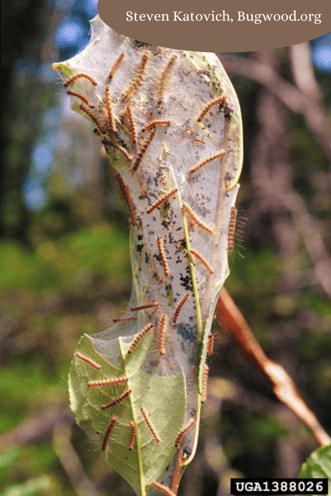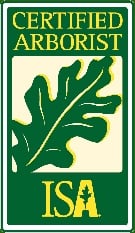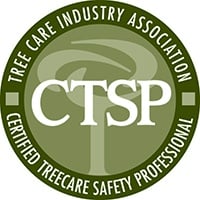We're sure you've seen it: Trees with branches covered in dirty webbing. The branches of your own trees may have been covered in webs at one point. If not, they may be in the future.
What's behind it all? It may be tiny, 1 1/2 inch caterpillars called fall webworms.
If your tree gets covered in webbing this summer, don't panic! It may seem alarming, but your tree probably isn't in danger if fall webworms are the culprits.
Hungry, hairy caterpillars
Fall webworms are fuzzy caterpillars with either black or rusty-orange heads and pale yellow or green bodies. Going down their backs are broad stripes with two rows of black bumps, and there are yellow patterns on their sides. They're found all over North America, Japan, and Korea.
These caterpillars feed on the leaves of more than 600 species of trees and shrubs, including pecan, persimmon, and sourwood trees in North Carolina. You'll most likely see their work mid to late summer.
Webworms have a lot of natural predators, and the last thing they want is to get eaten while they're enjoying a good meal themselves. That's where the webbing comes in. Once they find a spot to eat, fall webworms will create a web over the area (usually at the tips of branches), enclosing the leaves and protecting them from predators.
While fall webworms eat, they expand their webbing to include more leaves. These webs can end up being 2-3 feet long in some cases. The webbing may even seem to swallow smaller trees whole.
But here's the thing: even though fall webworms can cause defoliation, or the loss of foliage, they usually don't cause permanent harm. A few conditions save your tree from any lasting damage:
- Fall webworms are late season defoliators, meaning they feed at the end of the growing season. By that time, the tree is pretty much done growing and leaves have created just about all the food the tree needs.
- Fall webworms only eat what they've sectioned off for themselves in their web. A healthy, mature tree has plenty of leaves — the leaves it may lose to webworms isn't much compared to the full crown. Although, the same amount of feeding may damage younger trees since they don't have as much foliage.
New leaves should sprout next year as they have in the past since fall webworms don't bother with new leaf buds. That webbing may look bad as it turns from white to brown and covers more of your tree than you would like, but your tree will most likely be fine in the end.
.png?width=590&name=Fall%20webworm%20damage%20(1).png)
DIY fall webworm control
All it takes is a good storm to wash the webbing out of your tree, but we understand if you want that gross webbing out of your tree ASAP.
Use a rake or stick to pull them out of your tree and into a bucket of soapy water. Let that soak for a few hours to kill all the worms.
You can also prune the affected branches in minor cases. Be careful not to remove too much of the tree's overall foliage at one time — 20% or less is a good rule of thumb.
Fortunately, webworms aren't creatures of habit. They usually don't hit up the same trees year after year, let alone the same branch. So, once they're gone, they're typically gone for a while.
Want to learn about other pests you may see this summer? Check out our Summer Tree & Pest Manual.







